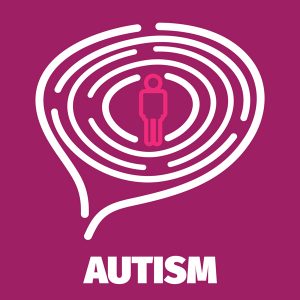Autism Spectrum Disorders (ASD) are a broad range of disorders that affect the cognitive ability of a person interacting with people in society.
 Areas of interaction disorders that a person with ASD displays include social interaction, communication/language and behavior problems.
Areas of interaction disorders that a person with ASD displays include social interaction, communication/language and behavior problems.
According to research, Autism spectrum disorders have been linked to neuro-developmental delays in children that have displayed odd behaviors during their infancy.
Behaviors
Some of these behaviors include rocking back and forth, moving their hands and arms in non-typical ways (i.e. robotic and not fluid movement), having an intense interest in ordinary things such as train schedules, license plates, and memorizing the phone book.
These odd behaviors create a stigma for persons with ASD in which society believes that all people that have ASD have these same behaviors.
ASD is based on a broad spectrum of disorders that incorporates people with ASD in many levels of distorted behavior and intellect.
These behaviors can be very mild to very severe. This is also true with levels of intellect that a person with ASD has. A person with ASD has been categorized into three groups based on their cognitive intellect:
- low functioning
- medium functioning
- high functioning
Specific diagnosis that encompass high functioning ASD include Asperger’s and pervasive developmental disorders(PDD). However, people with Asperger’s and PDD have the most difficult time with social interaction.
Misdiagnosis of ASD
A major issue that people with ASD face is misdiagnosis and late intervention by federal/government services. In 2001 a report was published by The National Autistic Society in the UK titled “Ignored or Ineligible”.
It described how and why people with ASD were denied social services and were never reported to local government agencies1. This explains why the statistics of people having ASD in the UK from 1990-2001 was so low.
A need for accurate diagnosis
The report summarized how people that have ASD were very commonly misdiagnosed with having another psychological disorder (i.e. schizophrenia, manic depression, bi-polar etc…) and were denied proper assessment and services from government agencies1.
One reason for the misdiagnosis was there was no established criterion based gold standard to use to properly diagnosis a person with ASD1.
It was diagnosed too late…
Another problem was that a child with ASD was often diagnosed too late which often put an unjust burden on families with loved ones suffering ASD.
The majority of people with ASD are not properly cared for and trained in skills that would enable them to perform activities of daily living for themselves, find a job when they became adults and learn to interact with peers to become a part of their community1.
The parents role
The parents of the child with ASD often must give up their careers and social life in order to tend to the child with 24 hour care, 365 days a year.
The report clearly demonstrates that early diagnosis of ASD and early intervention (i.e. birth to 3 years old) is essential.
The lack of services
Another issue that was prevalent in the UK in the early 2000s was the lack of services that were available to people with ASD and Asperger’s syndrome.
The reason for this was there were very few reported cases of true autism to local agencies.
Consequently, there were few qualified people or social and occupational services to help people with ASD successfully integrate into the community and develop life skills. Lack of budgeting for these services made it difficult for families with children with ASD to access them1.
In the USA
Today in the USA, children with ASD are diagnosed by observing behavior and categorizing the disorder according to the criteria outlined in the Diagnostic and Statistical Manual of Disorders-4th edition (DSM-IV: American Psychiatric Association).
According to the DSM-IV, ASD covers disorders such as autistic symptoms, Asperger’s Disorders, Pervasive Development Disorders (PDD), Disorders not already specified, Rett’s Disorder and Childhood Disintegrative Disorders2.
Educational benefits
Children with ASD are eligible to receive educational benefits that are given through Individuals with Disabilities Educational Improvement Act (IDEIA) and section 504 of the Rehabilitation Act of 19732,4.
Section 504 and IDEIA mandates that public schools provide a free and appropriate education to children with disabilities4. Children with higher level intellect ASD can qualify under special education under IDEIA2.
The child may be eligible under special categories such as gifted or specific learning disabilities.
Reprinted with permission from Keith Chittenden, WatchFit.com
References:
1. Barnard J, Harvey V, Potter D, Prior A. Ignored or Ineligible? The reality for Adults with Autism Spectrum Disorders. The National Autistic Society report for Autism Awareness week 2001. 2001. London, UK.
2. Adreon D, Durocher JS. Evaluating the College Transition Needs of Individuals with High-Functioning Autism Spectrum Disorders. Intervention in School and Clinic: 2007; 42: 271-279
3. Van Wieren AT, Reid CA, McMahon BT. Workplace discrimination and autism spectrum disorders: The National EEOC Americans with Disabilities Act Research project. Work: 2008; 31: 299-308
4. Fleischer DJ, Zames F. The Disability Rights Movement: from charity to confrontation. Temple University Press. Philadelphia, PA. 2001
5. Olmstead D. Weekly Wrap: No, Adam Lanza Did Not Have Asperger’s. Age of Autism. 2014. Accessed on 5/28/2014

